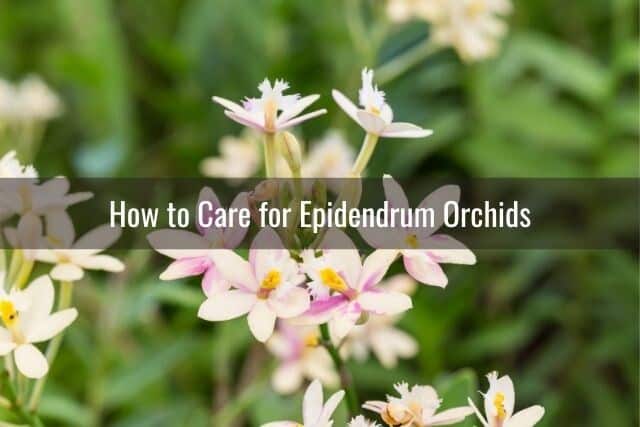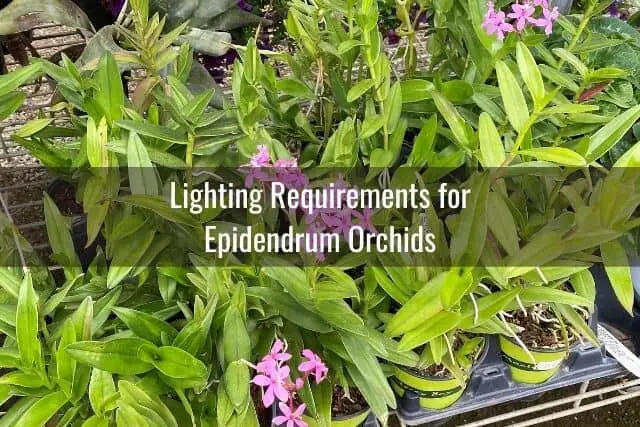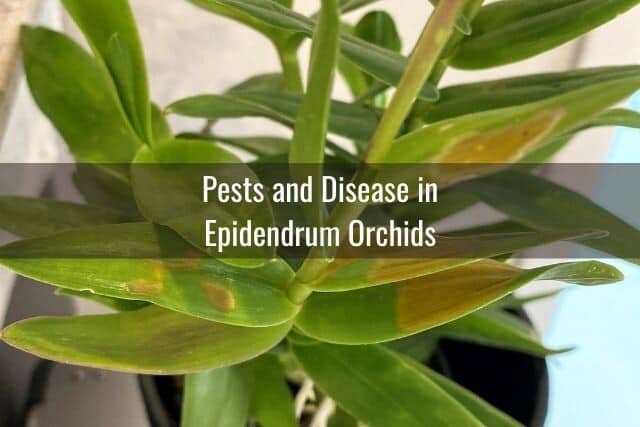Are you wondering how to care for your new Epidendrum orchid? Well, you’re in luck. Epidendrium orchids have a reputation for being one of the easiest orchids to care for.
Epidendrum orchids are great beginner orchids. These orchids require bright indirect light and weekly watering. They prefer mild to warm temperatures ranging from 50 to 90 degrees Fahrenheit and humidity levels ranging from 50 to 80%. Fertilize weekly during the growing season and every other week during the blooming season. Repot once every few years or only as needed. On top of all that, Epidendrum orchids are easy to propagate and raise.

There are over 1500 different types of Epidendrum orchids out there. This number includes hybrid species. Chances are, you’ve seen this lovely orchid in homes or gardens and maybe didn’t even realize it. These orchid flowers do not look like your typical orchid. Curious? Keep reading to learn more about these orchids.
Please note that these links are affiliate links and as an Amazon Associate, I earn from qualifying purchases. Purchases made through affiliate links in this post may generate commissions at no additional cost to you. Use this link for a discounted Amazon Prime trial. Thank you for your support!
Table of Contents
Epidendrum Orchids Are Easy to Grow

Epidendrum orchids are one of the more common orchids available. These are also among the easiest orchids to grow, making them great for beginners or growers who simply don’t want to deal with the needs of “fussier” orchids.
Epidendrum orchids are tough, hardy plants. They are also quite forgiving. As far as orchids go, these are very low-maintenance. They can tolerate a range of growing conditions. Epidendrum orchids can be mounted on trees, potted and grown indoors, or added to an outdoor flower bed. Rather than worrying about using purified or distilled water, you can safely use tap water to water Epidendrum orchids.
One thing to know is that Epidendrums do not like changes in growing conditions once they have grown accustomed to a certain location. When you find the right spot for your Epidendrum orchid in your house, try to avoid relocating it. They don’t appreciate being moved once they are established.
Also try to avoid unnecessary or frequent repotting of this orchid. Repeatedly changing the location of your orchid or repotting it can be detrimental to its health. This is because it will need to repeatedly try to adjust to a new environment and growing conditions.
How to Care for Epidendrum Orchids

Most Epidendrum orchids are epiphytes, meaning they do not grow in the soil like a terrestrial orchid would. Instead, they attach their roots to the sides of trees and rocks in the wild.
There are a few terrestrial Epidendrum orchids in existence, but the majority of the ones you may come across at your local garden center are epiphytes.
If you have recently purchased an Epidendrum orchid and are curious about how to care for it, look no further. Next, I’ll go over the main points you will need to know to successfully care for your Epidendrum orchid.
Temperature Tolerance for Epidendrum Orchids

These orchids can tolerate temperatures as low as 50 degrees Fahrenheit at night and as high as 90 degrees Fahrenheit during the day. Most types of Epidendrums cannot tolerate freezing temperatures.
Many of these orchids are more suited for indoor or greenhouse living, rather than outdoor living. The exception to this would be if you live in a place such as Florida or Southern California. In locations like Florida, where humidity is high and nightly temperatures remain mild year-round, it is possible to keep Epidendrum orchids outdoors. This is same for those living in Southern California, where temperatures are normally mild year-round.
Please note that while most Epidendrum orchids can tolerate a temperature range between 50 and 90 degrees Fahrenheit, different Epidendrum species do have varying temperature tolerance ranges. Some species may prefer temperatures tending towards the warmer end of the range. Others may prefer cooler temperatures. As always, it is best to check what type of Epidendrum species you have to find the exact growing conditions best suited for that orchid.
Lighting Requirements for Epidendrum Orchids

Bright, indirect light is ideal for Epidendrum orchids. These are medium to high light orchids. They can tolerate partial to full sun. If you have an east-facing window, that would be the perfect location for this orchid. To find out what kind of lighting your orchid growing area has, and how much light an orchid needs, read more about lighting and orchids.
If you notice that your orchid is getting “leggy,” and not producing blooms, the culprit may be inadequate lighting. An orchid that is healthy, growing taller and still not producing any blooms is a “leggy” plant. Those orchids are trying to grow to reach the light.
To address this, you can try to move your orchid to a location with more light. If your house lacks good natural lighting, you can also invest in artificial lighting to supplement your orchid’s lighting needs.
In general, Epidendrum orchids like at least 2500 to 3500 foot candles of light. This is similar to the lighting needs for Cattleyas. More light is fine too. These orchids, with good airflow and adequate humidity, can tolerate some full sun. However, if you see the leaves start to lighten or change color, take notice.
Reddish or brownish-bronze leaves are an indicator of too much light. If you see this, use a thin curtain such as this linen curtain to cover the window and reduce the intensity of light exposure. Alternatively, you can move the orchid farther away from the light (moving just this once should be fine).
Watering Needs for Epidendrum Orchids

The growing season for Epidendrum orchids is from early March to late September or early October. During the growing season, water your orchid more frequently, about every five days. These orchids like to be watered generously during the growing period. Try to keep the potting media moist, but not soggy.
The blooming, or flowering, season for Epidendrum orchids lasts from October to March. During this time, the orchids need less water and can get by with less frequent watering. Once a week would be adequate. Allow the potting media to become nearly dry between watering sessions.
When you do water, make sure you water thoroughly. Use room-temperature water to avoid shocking the orchid. Thoroughly saturate the potting media during each watering session and allow the excess water to drain from the pot. I personally like to soak my orchid pots in a shallow basin of water for at least five to ten minutes each week. This gives the roots and potting media time to absorb the water.
Also, as a general rule, water your orchids early in the morning. This will give the potting media a chance to dry out before nightfall.
Before watering, use your finger to check the top inch or two of the potting media. You want the potting media to nearly dry out between waterings but not get completely dry. It is a fine balance between not watering enough, which can lead to dry, dehydrated roots, and watering too much, which can lead to root rot.
Fertilizing Your Epidendrum Orchid

Fertilize your Epidendrum orchid with a diluted orchid fertilizer once every two weeks during the growing season. When the orchid enters its flowering season from October to March, you can slow down on fertilization. During the blooming period, you can get away with fertilizing just once a month.
Use a balanced fertilizer that is specifically designed for orchids. Proper fertilization of your Epidendrum orchid will help it grow greener leaves, stronger roots, and produce more bountiful blooms.
Be aware that high-nitrogen orchid fertilizers, combined with low levels of lighting, will result in a leggy orchid.
Humidity Requirements for Epidendrum Orchids

Most Epidendrum orchids prefer a humidity level of around 50% to 80%. Many homes have humidity levels of 30-50%, depending on the climate and location. If you aren’t sure what the humidity levels in your home are, you can find out using a hygrometer. This little device will help you keep track of humidity levels in your home and will allow you to make adjustments as needed.
You can provide additional humidity for your orchid by using a humidifier such as this one or setting up a humidity tray. Another way to increase humidity around your orchid is to mist your orchid.
When misting, try to avoid misting the leaves too much and just focus on the roots, especially the aerial roots. Misting, however, provides only transient increases in humidity. It is less effective than using a humidifier or humidity tray.
When providing adequate humidity for your orchids, don’t forget about also providing good air circulation around your plants. This will help prevent mold and other fungal or bacterial diseases from taking advantage of the high humidity and attacking your plant.
Good air circulation will also help the orchid manage warm temperatures, help the potting media dry out, and will mimic what an epiphyte orchid may normally experience in the wild.
Potting Media and Repotting Tips for Epidendrum Orchids

Epiphytic Epidendrums can be potted in a mix of fine-grade and medium-grade orchid potting media. The roots of these orchids are thin, similar to the roots of Dendrobium orchids. For this reason, when I repot my Epidendrum orchid, I create a mix of about 70% fine-grade orchid potting media with about 20% medium-grade potting media and 10% perlite.
Honestly, these percentages are rough. I usually just eyeball everything, but mostly use fine-grade potting media to support the thin, tendril-like Epidendrum roots. I have seen other websites recommend an equal mix of fine-grade and medium-grade orchid potting mix. You can try different ratios and see what works best for your orchid. In general, you want to get a potting mix that would allow for good airflow between the roots, while supporting the plant.
These orchids like to be pot-bound, so can get by with less frequent repotting. In general, you can repot your Epidendrum orchid once every three years. When you do repot, try to do it during the growing season, when the orchid is not in bloom. Otherwise, you risk the orchid flowers falling off early.
If your orchid has root rot, disease or a pest infestation, it may require repotting sooner than expected. In normal circumstances, Epidendrum orchids do not need to be repotted early unless they are visibly outgrowing their pot.
When repotting, use an orchid pot that is just big enough to fit all the roots. Unlike with Phalaenopsis orchids or orchids with pseudobulbs, you do not need to use a larger pot each time you repot. Too much potting media in proportion to the amount of roots will lead to root rot. Instead, use a pot that is just big enough to fit the roots and some potting media. Remember, these orchids prefer to be pot-bound.
Top-heavy orchids may need to be staked to prevent the orchid from toppling over. You can also try double-potting your orchid, using a heavy pot for the outer pot to help balance the orchid’s weight.
Terrestrial Epidendrum Orchids
Terrestrial Epidendrums, such as the Epidendrum Radicans, can be planted in loamy soil with some sand mixed in. If you want to know more about terrestrial orchids and their general care, please check out my article about terrestrial orchids. Many terrestrial orchids can be incorporated into outdoor gardens and flower beds.
If you have a terrestrial Epidendrum, you do not need to replant it every few years as a means of repotting. Instead, just add new orchid potting medium to the surface around terrestrial orchids. Do this when you notice the old medium starting to break down and decompose.
Flowering Information for Epidendrum Orchids

The wonderful thing about Epidendrum orchids is that these orchids are proliferative bloomers. Epidendrums can flower multiple times a season. This gives orchid growers many opportunities to enjoy the blooms.
Epidendrum orchid flowers are a cluster of small orchid blooms on flower spikes at the end of each cane. Usually the blooming season lasts from October to March. Flowers remain on the flower spikes anywhere from three weeks up to two months before falling off. Some species have scented flowers. Other species may have striped, spotted, or single-color blooms.
To trigger reblooming in your Epidendrum orchid, prune off spent blooms with a pair of sterilized gardening shears or scissors. If growing conditions are right, you will find your orchid reblooming in a couple of months.
If you are noticing that your reed-stem Epidendrum is not blooming, try adjusting its lighting or watering conditions. Usually inadequate lighting leads to blooming problems. Lower nighttime temperatures and less watering may also help trigger reblooming. For more information, read this Everyday Orchids guide on how to get orchids to rebloom.
Pests and Disease

The main thing to remember is that you will need to regularly inspect your orchid for any signs of pest or disease. Try to catch and stop any pest infestation early. This is true for any orchid.
While Epidendrum orchids can technically be affected by most orchid pests and diseases, aphids and brown scale in particular can be a problem. This is because the blossoms of the Epidendrum produce nectar. Nectar attracts ants and ants carry scale. This introduces brown scale to the orchid plant.
Soft brown rot and brown spot are also two types of disease that can affect Epidendrum orchids. To prevent this, try to maintain good airflow around the orchid, avoid crowding between plants, and water the roots only with clean water.
If you notice brown spots on your orchid leaves, use a sterilized blade to remove those leaves. Treat the cut ends with ground cinnamon. If the brown spotting is wide-spread, you can use a bactericide or fungicide spray such as Physan 20 to further treat your orchid plant. Before you use it on your orchids, be sure to dilute it first: dilute 2 teaspoons of Physan in 1 gallon of water.
Propagating Epidendrum Orchids

Propagating Epidendrum orchids is relatively easy. If you notice roots growing on the side of an orchid cane, this is the beginning of an orchid keiki, also known as a plantlet. Allow the roots to grow to be at least 2 or 3 inches long and the keiki to grow to one-third of the mother orchid’s size before trying to remove the orchid keiki.
You can learn more about how to propagate orchids and how to care for orchid keiki using these links.
Final Thoughts
Epidendrum orchids are a great addition to any orchid collection. They have unique blooms and flower frequently, providing color and beauty to homes and gardens. These orchids are pretty easy-going and forgiving. Their growing needs are suited for most people and make great beginner orchids.
If you enjoyed this article, please pin it and share!





